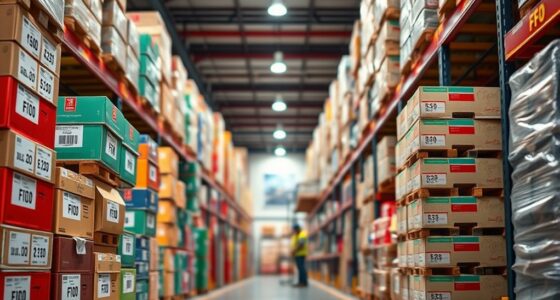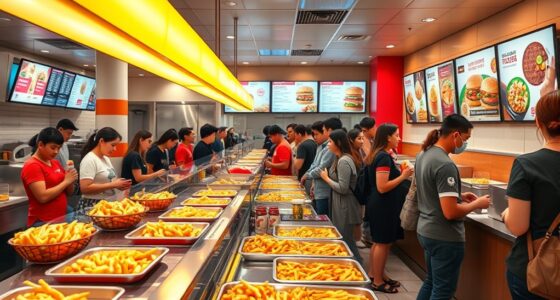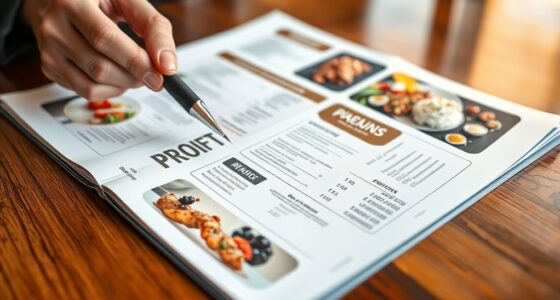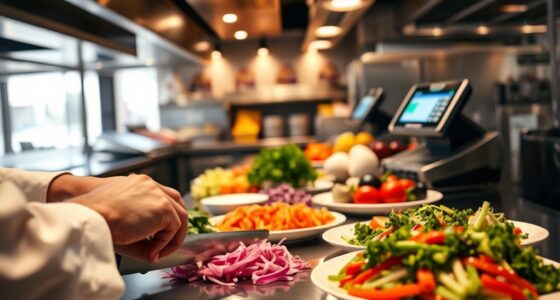Prime cost in restaurants combines your food and beverage costs with labor expenses, making it a crucial measure of profitability. By actively managing these two areas, you can control waste, prevent overstaffing, and boost your profit margin. Tracking prime cost helps you spot issues early and adjust operations accordingly. Want to discover effective strategies for managing these costs and improving your restaurant’s bottom line? Keep exploring to learn more.
Key Takeaways
- Prime cost combines Cost of Goods Sold (COGS) and labor expenses in a restaurant.
- It is a crucial metric for measuring overall profitability and operational efficiency.
- Managing prime cost involves controlling inventory, reducing waste, and optimizing staff scheduling.
- Keeping prime cost in check helps maintain healthy profit margins and financial stability.
- Regular monitoring and active management of prime cost improve restaurant performance.

Have you ever wondered what makes or breaks a restaurant’s profitability? It all comes down to managing your costs wisely, and prime cost is the key metric that reveals how well you’re doing in that regard. Prime cost combines your cost of goods sold (COGS) and labor expenses, giving you a clear picture of the core expenses that directly impact your bottom line. When these costs are in check, your restaurant can operate smoothly and generate sustainable profits. But understanding and controlling prime cost isn’t just about tracking numbers—it’s about actively managing vital components like inventory management and labor efficiency. Implementing effective wall organization systems can also streamline back-of-house operations and reduce clutter, contributing indirectly to cost control.
Managing prime cost is essential for restaurant profitability, focusing on controlling COGS and labor expenses through effective inventory and staff management.
Inventory management plays a pivotal role in controlling your prime cost. When you have a tight grip on inventory, you prevent waste and overstocking, which can greatly cut down your COGS. Regularly monitoring stock levels and accurately forecasting demand ensures you’re purchasing only what you need, reducing spoilage and theft. Efficient inventory management means you’re not tying up cash in excess ingredients that could go bad or be stolen, which directly boosts your profitability. It also helps you identify slow-moving items, enabling you to adjust menus or promotions to move inventory faster, further controlling costs. When inventory is managed well, your food costs stay predictable, and your profit margins improve.
Labor efficiency is just as essential to managing prime cost. You want to guarantee your staff is working at peak productivity without being overstaffed or understaffed. This requires careful scheduling based on anticipated customer volume, avoiding unnecessary labor costs. By training your team to work efficiently and cross-train employees, you can reduce idle time and improve service speed, which enhances customer satisfaction while keeping labor costs in check. Analyzing sales data and adjusting staffing levels accordingly helps you avoid overspending on wages. Remember, labor costs are often one of the largest expenses in a restaurant, so optimizing labor efficiency directly influences your prime cost and overall profitability.
Ultimately, controlling prime cost involves a balance—keeping inventory lean and managing labor smartly. When you focus on these areas, you’re not just cutting expenses; you’re creating a more efficient operation that can adapt to changing demands and improve profit margins. Regularly reviewing these components helps you spot issues early and make informed decisions. Keeping a close eye on your prime cost, through diligent inventory management and labor efficiency, empowers you to run a healthier, more profitable restaurant.
Frequently Asked Questions
How Is Prime Cost Calculated in Restaurants?
You calculate prime cost in restaurants by adding ingredient costs and labor expenses. First, track how much you spend on ingredients for your menu items, then sum up all labor expenses, including wages and benefits. Next, combine these two figures to get your total prime cost. This helps you understand your main operating expenses and manage your budget effectively, ensuring your restaurant stays profitable.
Why Is Prime Cost Important for Restaurant Profitability?
Think prime cost is just a number? Think again! It’s your secret weapon against food waste and staff inefficiency. By monitoring prime cost, you spot where money slips away—whether from spoiled ingredients or sluggish service. Keep it in check, and you’ll boost profit margins, impress investors, and maybe even afford that fancy new coffee machine. Ignore it, and your restaurant’s financial health becomes a game of Russian roulette.
What Is the Ideal Prime Cost Percentage for Restaurants?
You should aim for a prime cost percentage around 60-65% for your restaurant. This balance helps with menu pricing and makes sure you maintain labor efficiency. Keeping prime costs within this range allows you to price your menu items competitively while controlling labor and food expenses. Regularly monitor these percentages to identify areas for improvement, helping you boost profitability and sustain a healthy, efficient operation.
How Can Restaurants Reduce Their Prime Cost Effectively?
To reduce your prime cost effectively, focus on controlling menu pricing and staff training. Regularly review your menu to eliminate high-cost, low-margin items, and adjust prices accordingly. Invest in staff training to improve efficiency, reduce waste, and enhance service. Implementing these strategies creates a streamlined operation, lowers expenses, and boosts profitability—all while maintaining quality and customer satisfaction. Consistent monitoring keeps your prime costs in check and your restaurant thriving.
Does Prime Cost Include Marketing and Administrative Expenses?
Prime cost typically doesn’t include marketing expenses or administrative costs, as these are considered operating expenses. When you calculate prime cost, you focus on direct costs like food and labor, which directly impact your restaurant’s profitability. Marketing expenses and administrative costs are essential for overall business success but are categorized separately in your financial statements. Keep track of these to manage your budget effectively and improve your restaurant’s financial health.
Conclusion
Remember, understanding prime cost helps you keep your restaurant profitable. Focus on controlling food and labor costs, and you’ll be well on your way to success. Think of it like tending a garden—you need to nurture the right elements to see your business flourish. As the saying goes, “A stitch in time saves nine.” Stay vigilant and proactive with your prime cost management, and you’ll guarantee your restaurant stays healthy and thriving.









